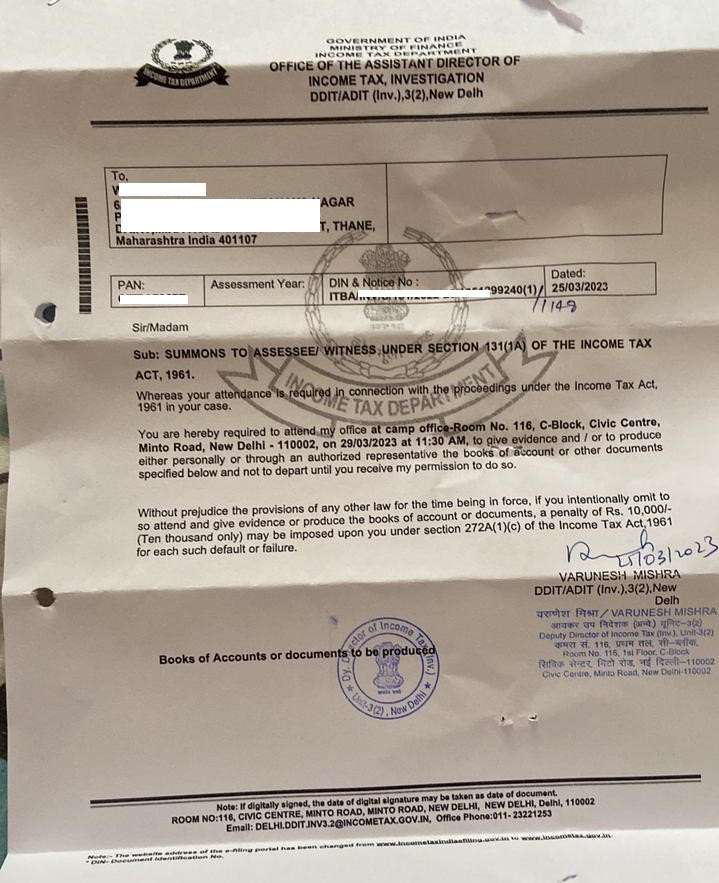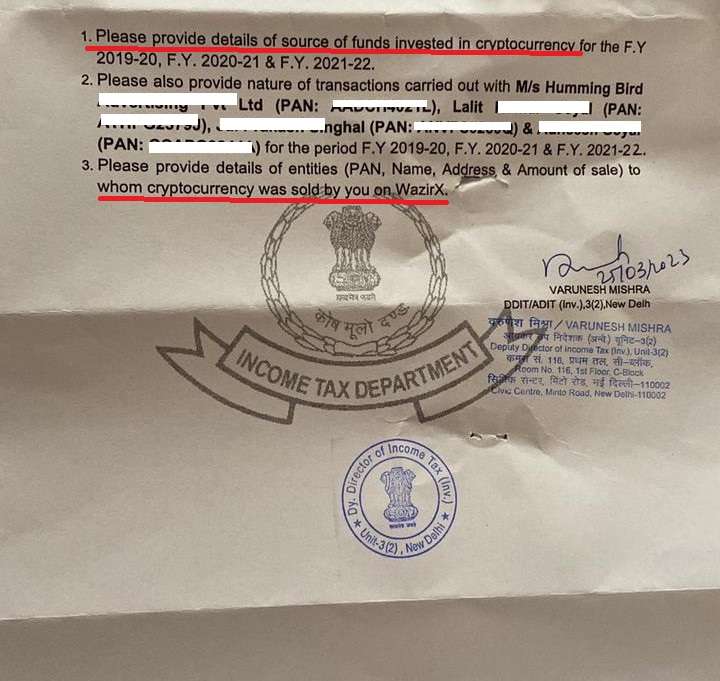
Types of Income Tax Notices - 2025 India
In this article we will discuss various Types of Income Tax Notices and their meaning. We will also cover some FAQ on Income Tax Notices
Table of Contents
- Types of Income Tax Notices
- Notice u/s 139(9) - Defective Income Tax Return
- Notice u/s 142(1) - Inquiry before Assessment
- Notice u/s 143(1) - Intimation
- Notice u/s 143(2) - Scrutiny
- Notice u/s 148 - Income Escaped Assessment
- Notice u/s 156 - Demand Notice
- Notice u/s 245 - Refund Adjusted against the Tax Demand
- Difference between Income Tax Notice and Assessment
- Section 143(3) - Scrutiny Assessment
- Section 144 - Best Judgement Assessment
- Section 131(1A) - Income is concealed or likely to be concealed
- Frequently Asked Question (FAQ) on Income Tax Notices
- What exactly is an income-tax notice?
- How Should You Handle Income Tax Notices from the IT Department?
- What is the purpose of an income-tax notice?
- How do I find out if an income-tax notice has been issued to me or what the status of the notice is?
- Can I get more than an Assessment Year Income Tax Notice?
- If I don't know an income tax notice, what could happen?
- What are my chances of receiving a notification from the Income Tax Department?
- How long is the notice of income tax received from me normally taken?
- I am currently living outside of India; how should I approach the Income-tax Department in this situation?
- What is a limited Scrutiny?
- When is the Notice Sent to The Assessee?
- How to deal with the Notice u/s 142(1)?
- Notices being received by our Crypto clients u/s 142 (1) and u/s 148A
- What are the penalties for non-compliance with Section 142(1) Tax Notice?
- What is the time limit for income tax notice?
- Why Only Expert Tax Consultants Should Handle Your IT Scrutiny Notice?
- Conclusion
Types of Income Tax Notices
Notice u/s 139(9) - Defective Income Tax Return
In this case, the Assessing Officer (AO) is of the opinion that ITR filed by the assessee is defective then he may issue notice u/s 139(9). AO also shares the proper error description along with the probable solution to rectify the same. The defect u/s 139(9) can be because of the wrong ITR filed, wrong or non declaration of Income as per Form 26AS, missing information, incomplete return etc.
The Assessee is given an opportunity to respond within 15 days from the date of intimation and if he don't respond within stipulated time, the AO will consider the return invalid and proceed for assessment.
Assessee may agree or disagree with the observation of the AO. If you can agree, you can file a return after rectifying the defect in the return.
Notice u/s 142(1) - Inquiry before Assessment
The purpose of this notice is to request additional information and documentation from the taxpayer in order to complete the processing of their filed return. This notice will also be sent to compel a taxpayer to furnish additional documents and details. Also, if the Assessee has not filed their return on time, they will receive a notice for a preliminary inquiry u/s 142(1). The time limit to serve the notice u/s 142(1) is before the end of the relevant assessment year.
Have you received any income tax notices? Trust us to assist you in responding to the IT Department. Our team at CA Mitesh & Associates is well-versed in engaging with the Income Tax Department. By assisting you in responding properly, our team will help you avoid legal repercussions and penalties.
Notice u/s 143(1) - Intimation
Notice u/s 143(1) is one of the most common income tax notice that is frequently received by taxpayers from the income tax department, it requires a response to rectify errors, incorrect claims, or inconsistencies in a filed income tax return. If an individual receives this notice and wishes to amend their return, they have a 15-day window to do so. Otherwise, the tax return will be processed after incorporating the necessary adjustments specified in the notice.
Notice u/s 143(2) - Scrutiny
If the Assessee's response to the Income Tax Notice u/s 142(1) is deemed unsatisfactory by the Assessing Officer or if the Assessee fails to provide the requested documents, they will receive a notice u/s 143(2).
There can be 3 types of following notices under Section 143(2):
Limited Scrutiny: This is a Computer-Assisted Scrutiny Selection (CASS) where cases are selected based on set parameters. The scrutiny will be limited to the particular area of return mentioned in the notice. An example of this scrutiny can be a mismatch in tax credits, inaccurate information, etc.
Complete Scrutiny: A complete scrutiny is carried out on the return filed along with all supporting documents. Cases are flagged based on CASS. The scope of scrutiny is not limited to these types of notices. However, the assessing officer cannot verify documents beyond the particular assessment year.
Manual Scrutiny: Cases are selected for complete scrutiny based on the criteria defined by the Central Board of Direct Taxes; the criteria may vary every year.
Taxpayers who receive notice under Section 143(2) will have to submit additional information. The Assessee or their authorized representative may file a reply through the portal as physical submissions are no longer required, and the process will be conducted exclusively through E-Assessment.
Notice u/s 148 - Income Escaped Assessment
In situations where the assessing officer suspects that the income disclosed by an individual is incorrect, resulting in underpayment of taxes, or if the individual has failed to file a return despite being legally obligated to do so, then he will issue notice u/s 148 and it is considered as income escaping assessment. In such cases, the assessing officer has the authority to assess or reassess the income. Before proceeding with the assessment or reassessment, the officer must serve a notice to the assessee requesting them to provide their income return. This notice is issued under Section 148 of the income tax provisions.
The notice can be served within 4 years / 6 years / 16 years from the end of the relevant assessment year.
Notice u/s 156 - Demand Notice
If any penalty, tax, fine or any other amount is due from the taxpayer to the Income Tax Department then Income Tax notice u/s 156 is served. Normally this notice is served after the assessment of ITR. The taxpayer can deposit the amount payable within 30 days from the date of the Income Tax notice. There is no time limit to serve this notice. Income tax notice u/s 143(1) and 200A are also referred as Notice of Demand.
Notice u/s 245 - Refund Adjusted against the Tax Demand
It is basically an Intimation from the Income Tax Department. This notice is issued when the tax refund (full/partial) for an assessment year is adjusted against the tax demand due from the taxpayer. It is issued in cases where the assessing officer suspects that tax payment has been evaded in previous years and wishes to offset the current year's refund against the outstanding demand, a notice u/s 245 may be issued.
However, such an adjustment can only be made after the individual has been given a proper notice and a chance to be heard. The recipient of the notice is required to respond within 30 days of receiving it. Failure to do so may be considered as implied consent by the assessing officer and the assessment process may be initiated accordingly. As such, it is recommended to respond to the notice promptly.
Have you received any income tax notices? Trust us to assist you in responding to the IT Department. Our team at CA Mitesh & Associates is well-versed in engaging with the Income Tax Department. By assisting you in responding properly, our team will help you avoid legal repercussions & penalties.
Difference between Income Tax Notice and Assessment
| Notice | Assessment |
| An income tax notice is a written communication sent by the Income Tax Department to a taxpayer alerting an issue with his tax account. The notice can be sent for different reasons like filing/ non-filing their income tax return, making the assessment, asking for certain details, etc. | Once the return of income is filed up by the taxpayer, the next step is the processing of the return of income by the Income Tax Department. The process of examining the return of income by the Income-Tax department is called as “Assessment”. |
Section 143(3) - Scrutiny Assessment
Under section 143(3) of the Income Tax Act, Assessment refers to a detailed examination, commonly known as scrutiny assessment. In this Assessment, a thorough investigation of the return of income is conducted to verify the accuracy and authenticity of various claims, deductions, and other details provided by the taxpayer in their return of income.
The scope of assessment under section 143(3) primarily aims to confirm that the taxpayer has not understated their income, computed excessive losses, or underpaid taxes in any manner. To establish this, the Assessing Officer carries out a meticulous review of the return of income, carefully assessing the various claims, deductions, and other details provided by the taxpayer to ensure their accuracy and genuineness.
Detailed procedure of assessment under section 143(3)?
The notice under section 143(2) must be served within six months from the end of the financial year in which the return is filed. The taxpayer or their representative will then appear before the Assessing Officer to present their arguments and supporting evidence on various matters and issues as required by the Assessing Officer.
After hearing and verifying the evidence and taking into account all relevant materials gathered by the Assessing Officer, an assessment of the taxpayer's total income or loss will be made, and the sum payable by the taxpayer or the refund due to them will be determined based on the assessment. This assessment is made by the Assessing Officer in writing.
Section 144 - Best Judgement Assessment
Notice u/s 144 of the Income Tax Act 1961 is commonly referred to as Best Judgement Assessment or Ex Parte Assessment. In simple terms, if a taxpayer fails to respond to Income Tax notices or provide the documents and details requested, the Income Tax officer can proceed with an assessment and issue a demand notice based on their understanding, without seeking any further information from the taxpayer. This scenario can be particularly disadvantageous for the taxpayer, as they will be at a disadvantage if they wish to appeal the decision. Appealing can be both a costly and time-consuming activity for the taxpayer.
Have you received any income tax notices? Trust us to assist you in responding to the IT Department. Our team at CA Mitesh & Associates is well-versed in engaging with the Income Tax Department. By assisting you in responding properly, our team will help you avoid legal repercussions & penalties.
Section 131(1A) - Income is concealed or likely to be concealed
If the AO is of the opinion that the assessee is concealing the Income or likely to conceal Income then you will receive Income Tax notice u/s 131(1A). This notice is basically an intimation that AO is initiating an enquiry or investigate into the matter.
The assessing office can impound the books of account or other documents by providing reasons for the same. There is no specific time limit to serve this notice.
Before we move to FAQs on Income Tax Notices, lets summarise in this table the various Types of Income Tax Notices we have discussed today:
| Type of Notice | Description |
| Notice u/s 143(1) - Intimation | This is one of the most commonly received income tax notices. The income tax department sends this notice seeking a response to the errors/ incorrect claims/ inconsistencies in an income tax return that was filed.If an individual wants to revise the return after receiving this notice, it must be done within 15 days.Else, the tax return will be processed after making the necessary adjustments mentioned in the 143(1) tax notice. |
| Notice u/s 142(1) - Inquiry | This notice is addressed to the assessee when the return is already filed and further details and documents are required from the assessee to complete the process.This notice can also be sent to necessitate a taxpayer to provide additional documents and information. |
| Notice u/s 139(1) - Defective Return | An income tax notice under Section 139(1) would be issued if the income tax return filed does not contain all necessary information or incorrect information. |
| If tax notice under Section 139(1) is issued, you should rectify the defect in the return within 15 days. | |
| Notice u/s 143(2) - Scrutiny | An income tax notice under Section 143(2) is issued if the tax officer was not satisfied with the documents and information that was submitted by the taxpayer.Taxpayers who receive notice under Section 142(2) have been selected for detailed scrutiny by the Income Tax department and will have to submit additional information. |
| Notice u/s 156 - Demand Notice | This type of income tax notice is issued by the Income Tax Department when any tax, interest, fine, or any other sum is owed by the taxpayer.All demand tax notice will stipulate the sum which is outstanding and due from the taxpayer. |
| Notice Under Section 245 | If the officer has reason to believe that tax has not been paid for the previous years and he wants to set off the current year's refund against that demand, a notice u/s 245 can be issued.However, the adjustment of demand and refund could be done only if the individual has been provided proper notice and an opportunity to be heard. The recipient has to respond to the notice is 30 days from the day of receipt of the notice.If the individual does not respond within the specified timeline, the assessing officer can consider this as consent and proceed with the assessment.Therefore, it is advisable to respond to the notice at the earliest. |
| Notice Under Section 148 | The officer may have a reason to believe that you have not disclosed your income correctly and therefore, you have paid lower taxes.Or the individual may not have filed his return at all, even if you must have filed it as per law. This is termed as income escaping assessment. Under these circumstances, the assessing officer is entitled to assess or reassess the income, according to the case.Before making such an assessment or reassessment, the assessing officer should serve a notice to the assessee asking him to furnish his return of income.The notice issued for this purpose is issued under the provisions of Section 148. |
Frequently Asked Question (FAQ) on Income Tax Notices
What exactly is an income-tax notice?
The Income-tax Department processes an individual's / assessee's (also known as a taxpayer's) income-tax return when it is filed. If a mistake, inaccuracy, or inconsistency is discovered in the income-tax return filed, the Assessee is notified by way of an income-tax notice. The Income-tax Department issues a variety of income-tax notices, which you can read about in the question below.







Comments